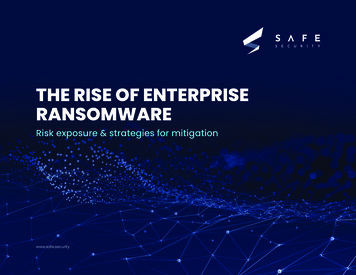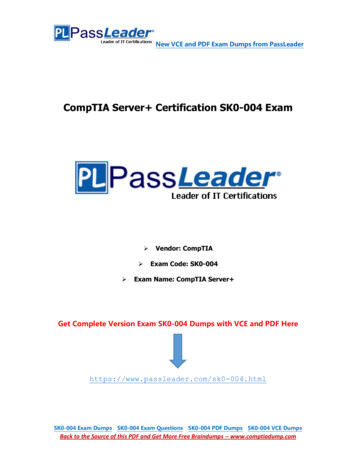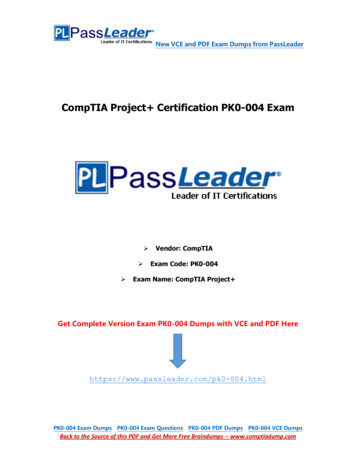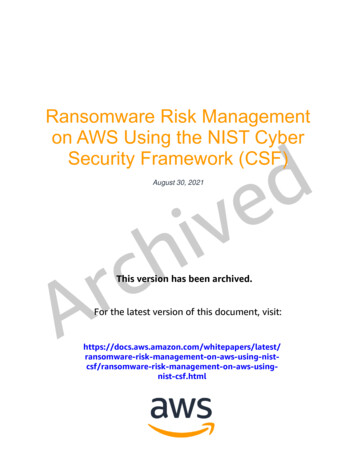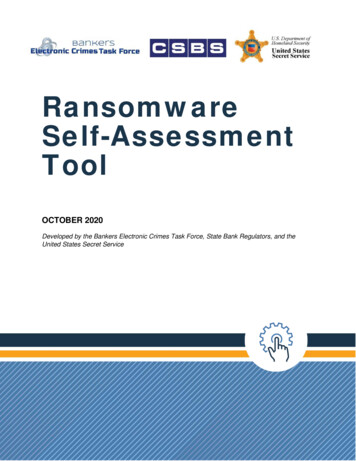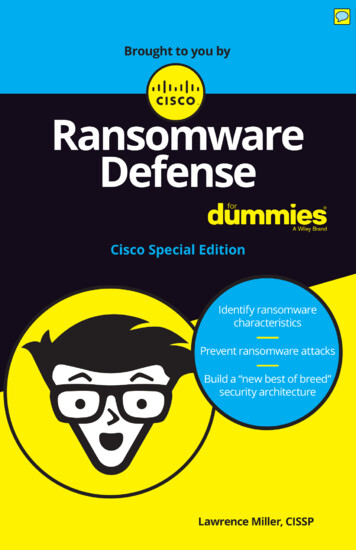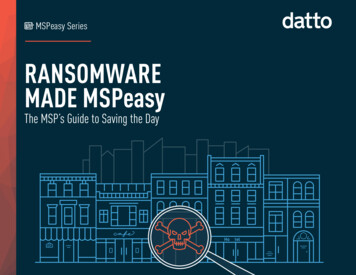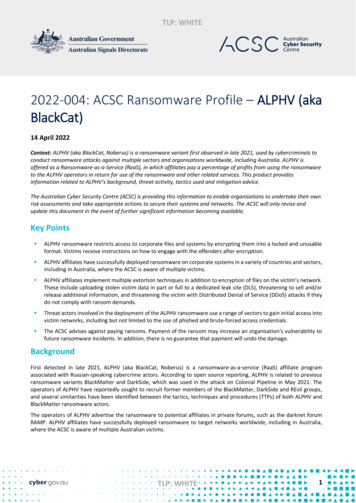
Transcription
TLP: WHITE2022-004: ACSC Ransomware Profile – ALPHV (akaBlackCat)14 April 2022Context: ALPHV (aka BlackCat, Noberus) is a ransomware variant first observed in late 2021, used by cybercriminals toconduct ransomware attacks against multiple sectors and organisations worldwide, including Australia. ALPHV isoffered as a Ransomware-as-a-Service (RaaS), in which affiliates pay a percentage of profits from using the ransomwareto the ALPHV operators in return for use of the ransomware and other related services. This product providesinformation related to ALPHV’s background, threat activity, tactics used and mitigation advice.The Australian Cyber Security Centre (ACSC) is providing this information to enable organisations to undertake their ownrisk assessments and take appropriate actions to secure their systems and networks. The ACSC will only revise andupdate this document in the event of further significant information becoming available.Key Points ALPHV ransomware restricts access to corporate files and systems by encrypting them into a locked and unusableformat. Victims receive instructions on how to engage with the offenders after encryption. ALPHV affiliates have successfully deployed ransomware on corporate systems in a variety of countries and sectors,including in Australia, where the ACSC is aware of multiple victims. ALPHV affiliates implement multiple extortion techniques in addition to encryption of files on the victim’s network.These include uploading stolen victim data in part or full to a dedicated leak site (DLS), threatening to sell and/orrelease additional information, and threatening the victim with Distributed Denial of Service (DDoS) attacks if theydo not comply with ransom demands. Threat actors involved in the deployment of the ALPHV ransomware use a range of vectors to gain initial access intovictim networks, including but not limited to the use of phished and brute-forced access credentials. The ACSC advises against paying ransoms. Payment of the ransom may increase an organisation’s vulnerability tofuture ransomware incidents. In addition, there is no guarantee that payment will undo the damage.BackgroundFirst detected in late 2021, ALPHV (aka BlackCat, Noberus) is a ransomware-as-a-service (RaaS) affiliate programassociated with Russian-speaking cybercrime actors. According to open source reporting, ALPHV is related to previousransomware variants BlackMatter and DarkSide, which was used in the attack on Colonial Pipeline in May 2021. Theoperators of ALPHV have reportedly sought to recruit former members of the BlackMatter, DarkSide and REvil groups,and several similarities have been identified between the tactics, techniques and procedures (TTPs) of both ALPHV andBlackMatter ransomware actors.The operators of ALPHV advertise the ransomware to potential affiliates in private forums, such as the darknet forumRAMP. ALPHV affiliates have successfully deployed ransomware to target networks worldwide, including in Australia,where the ACSC is aware of multiple Australian victims.TLP: WHITE1
TLP: WHITEThreat activityThe ACSC is aware of an increase in ALPHV activity globally in 2022 relative to other competing ransomware variants,including against Australian organisations. The ACSC is aware of ALPHV targeting government and critical infrastructureorganisations, as well as the energy, finance, construction and other sectors. In February 2022, ALPHV affiliatescompromised a German oil storage operator and an energy distributor. The ALPHV operators claim to exclude the use ofthe ransomware in attacks on healthcare and charitable organisations.In late March 2022, the ALPHV developers announced changes to the ransomware, reportedly including features toinhibit detection of ALPHV ransomware by antivirus and other signature-based detection systems using polymorphicfeatures that change parts of ransomware code.Tactics, Techniques and ProceduresALPHV is written in the ‘Rust’ programming language. ALPHV ransomware has the capability to target both Windows,and Linux systems, as well as ESXi virtualisation infrastructure.Threat actors deploying ALPHV ransomware use a range of initial access vectors to gain access to target networks,including: Exploiting known vulnerabilities or common security misconfigurations. Using legitimate credentials purchased, brute-forced or gained in phishing attacks, including credentials forRemote Desktop Protocol (RDP) connections and commercial Virtual Private Network (VPN) products.Once initial access is obtained, ALPHV actors establish reverse SSH tunnels as a command-and-control (C2) channelbetween victims and ALPHV infrastructure. Actors have been observed propagating ALPHV throughout victim networksusing PsExec. ALPHV ransomware can be configured to terminate VMware ESXi virtual machines (VMs), and to deleteVM snapshots and backups to prevent recovery efforts.Other observable Tactics, Techniques, and Procedures (TTPs) associated with ALPHV ransomware activity include but arenot limited to: Utilising PowerShell to alter Windows Defender security settings Utilising PsExec for lateral movement, tool transfer and execution. Utilising the publicly available penetration testing tool CobaltStrike for network access and lateral movement. Exfiltrating data to publicly available cloud file-sharing services.Post-ExploitationOnce encryption of victim data is complete, victims receive a ransom note directing them to either an email address ora URL, from which an affiliate will demand payment. ALPHV affiliates implement multiple extortion techniques inaddition to encryption of the victim’s network. These include: Uploading stolen victim data in part or full to a dedicated leak site (DLS) maintained on The Onion Router(TOR) network. Threatening to sell and/or release additional information. Threatening the victim with Distributed Denial of Service (DDoS) attacks if they do not comply with ransomdemands.ALPHV ransomware uses a unique access token feature to prevent third parties from monitoring and disrupting ransomnegotiations. This access token is used to create an access key needed to enter a dedicated victim portal on a TOR sitewhere ransom negotiations are conducted. In contrast to other ransomware variants, ALPHV is willing to engage withTLP: WHITE2
TLP: WHITEfirms hired to conduct ransom negotiations on behalf of victims, and features an ‘Intermediary’ login option on thevictim portal.AssistanceThe ACSC monitors a variety of ransomware variant activity, including ALPHV. The ACSC is able to provide assistanceand advice if required.All victims are strongly encouraged to report ransomware-related cybercrime and cyber security incidents to the ACSC.Organisations that have been impacted or require assistance in regards to an ALPHV ransomware incident can contactthe ACSC via 1300 CYBER1 (1300 292 371), or by submitting a report to cyber.gov.au.MITRE ATT&CK Techniques and Suggested MitigationsThe ACSC recommends to implement the following mitigations: Implement multifactor authentication to prevent actors from accessing valid accounts with stolen credentials. Implement network segmentation and network traffic filtering to prevent actors from directly connecting toremote access services they have established for persistence. Configure the Windows Registry to require User Account (UAC) approval for any PsExec operations requiringadministrator privileges to reduce the risk of lateral movement by PsExec. Implement hypervisor log monitoring and ensure that logs are processed on a separate system. Implement application whitelisting (at least in monitor mode to capture unusual activity). Perform daily backups and keep them offline and encrypted.The below table maps the mitigations to the techniques leveraged by the actor and to the resources to implementthese mitigations to protect your infrastructure.TechniqueProcedureMitigationsActors have obtained credentials forvalid accounts and used these to gainaccess to victim networks.Multi-factor authentication [M1032]Require multifactor authentication for all useraccounts, particularly privileged accounts. Thisprevents actors from accessing valid accounts withstolen credentials.Initial Access [TA0001]Valid Accounts[T1078]Actors have used phishing andpassword brute forcing techniques toobtain credentials. They have alsopurchased credentials or collectedthem from publicly available breaches.See also: Multi-factor Authentication - TechniqueD3-MFA Implementing Multi-FactorAuthentication Strategies to Mitigate Cyber SecurityIncidents – Mitigation DetailsUser training [M1017]TLP: WHITE3
TLP: WHITEEducate users to avoid password reuse. Thisprevents actors from obtaining credentialsthrough public breaches or by compromising noncorporate systems.See also: Creating Strong PassphrasesPersistence [TA0003]External RemoteServices [T1133]Actors have used remote accessservices, such as valid Remote DesktopProtocol and SSH credentials, topersist on victim’s systems.Filter Network Traffic [M1037]Prevent network traffic from unknown oruntrusted origins from accessing remote serviceson internal systems. This prevents actors fromdirectly connecting to remote access services theyhave established for persistence.See also: Inbound Traffic Filtering - Technique D3ITFNetwork Segmentation [M1030]Segment networks and restrict traffic for remoteaccess services where possible. This limits theability of threat actors moving laterally withincompromised networks. Utilising networksegmentation as a form of defence in depth alsoprevents actors from connecting to externalremote access services that they have establishedfor persistence via compromised systems withinvictim networks.See also: Broadcast Domain Isolation - TechniqueD3-BDI Implementing Network Segmentationand SegregationExecution [TA0002]System Services:Service Execution[T1569.002]Actors have used the legitimateWindows Sysinternals tool PsExec[S0029] to execute malicious content.Enable Attack Surface Reduction (ASR) onMicrosoft Windows 10, and configure ASR to blockprocess creations originating from PsExeccommands.Note: PsExec is commonly used for legitimatesystem administration tasks. Organisations shouldconsider how this mitigation could impactbusiness practices before implementing.See also:TLP: WHITE4
TLP: WHITE Hardening Microsoft Windows 10 version21H1 WorkstationsExfiltration [TA0010]Exfiltration OverWeb Service [T1567]Actors have exfiltrated data tolegitimate and publicly available webservices, including legitimate cloudstorage services.Encrypt Sensitive Information [M1041]Encrypt sensitive data at rest. This prevents actorsfrom accessing sensitive data even if they canaccess the systems storing the data.Network Segmentation [M1030]Segment networks to separate sensitive data, andservices that provide access to sensitive data,from corporate environments. This preventsadversaries from compromising vulnerablesystems, such as desktop environments, andimmediately accessing and exfiltrating sensitivedata.See also: Broadcast Domain Isolation - TechniqueD3-BDI Implementing Network Segmentationand SegregationRestrict Web-Based Content [M1021]Restrict access to web-based storage servicesfrom corporate networks, except where requiredfor legitimate business activity. This preventsactors from directly uploading sensitive data toblocked web-based storage services.Lateral Movement [TA0008], Privilege Escalation [TA0004], Discovery [TA0007]VariousActors have deployed the widely-usedpost-exploitation framework CobaltStrike on victim networks [S0154].Actors have also used the legitimateSysInternals tool PsExec [S0029].Network Segmentation [D3-BDI]Segment networks and restricting or monitorcertain types of traffic that are commonly used forlateral movement or reconnaissance. Thisprevents actors from moving laterally in networksand accessing sensitive systems or data.See also: Implementing Network Segmentationand SegregationPrivileged Account Management [M1026]Restrict administrative privileges to operatingsystems and applications based on user duties.This reduces actors’ ability to elevate privilege,TLP: WHITE5
TLP: WHITEmove laterally in networks, bypass securitycontrols and access sensitive data.See also: Restricting Administrative PrivilegesUpdate Software [M1051]Patch applications and operating systems andkeep them up to date. This prevents actors fromexploiting known vulnerabilities in applicationsand operating systems to elevate privilege, bypasssecurity controls and move laterally in networks.See also:System PatchingImpact [TA0040]Data Encrypted forImpact[T1486]Actors have used ALPHV ransomwareto encrypt valuable data, disruptoperations, and extort payment fromvictims.Backup Data [M1053]Perform daily backups and keep them offline andencrypted. Test recovery and integrityprocedures to make sure data and operationscan be quickly and reliably restored. This willallow business operations to be recovered if datais encrypted, reducing the impact of aransomware attack. Note that backups will notmitigate risks where sensitive data is exfiltratedand released.See also: Network Denial ofService [T1498]Actors have threatened victims withDistributed Denial of Service (DDoS)attacks to extort ransom payments.Data backup and restorationFilter network traffic [M1037]Monitor network traffic to identify possibledenial-of-service attacks, and filter or block attacktraffic. This service can be delivered by an ISP,CDN or other hosting provider.Prepare for denial-of-service attacksTake steps to prepare for, and mitigate thepotential impact of denial-of-service attacks. Forexample: TLP: WHITEEstablish disaster recovery plans forcritical systems.6
TLP: WHITE Establish out-of-band communicationprocedures and contact points. Partition critical online services (e.g.email) from services that are more likelyto be targeted (e.g. web hosting). Use cloud-based hosting from a majorservice provider, with high bandwidth andcontent delivery networks that cachestatic web content.See also: Preparing for and Responding to Denialof-Service AttacksDocument Change LogVersionDateChange summary114 April 2022First published.TLP: WHITE7
TLP: WHITETraffic light protocolTLP LevelRestriction on access and useNot for disclosure, restricted to participants only.REDSources may use TLP:RED when information cannot be effectively acted upon byadditional parties, and could lead to impacts on a party's privacy, reputation, oroperations if misused. Recipients may not share TLP:RED information with any partiesoutside of the specific exchange, meeting, or conversation in which it was originallydisclosed. In the context of a meeting, for example, TLP:RED information is limited tothose present at the meeting. In most circumstances, TLP:RED should be exchangedverbally or in person.Limited disclosure, restricted to participant’s organisations.AMBERSources may use TLP:AMBER when information requires support to be effectively actedupon, yet carries risks to privacy, reputation, or operations if shared outside of theorganisations involved. Recipients may only share TLP:AMBER information with membersof their own organisation, and with clients or customers who need to know theinformation to protect themselves or prevent further harm. Sources are at liberty tospecify additional intended limits of the sharing: these must be adhered to.Limited disclosure, restricted to the community.GREENSources may use TLP:GREEN when information is useful for the awareness of allparticipating organisations as well as with peers within the broader community or sector.Recipients may share TLP:GREEN information with peers and partner organisations withintheir sector or community, but not via publicly accessible channels. Information in thiscategory can be circulated widely within a particular community. TLP:GREEN informationmay not released outside of the community.Disclosure is not limited.WHITENot classifiedSources may use TLP:WHITE when information carries minimal or no foreseeable risk ofmisuse, in accordance with applicable rules and procedures for public release. Subject tostandard copyright rules, TLP:WHITE information may be distributed without restriction.Any information received from the ACSC that is not classified in accordance with theTraffic light protocol must be treated as AMBER classified unless otherwise agreed inwriting by the ACSC.TLP: WHITE8
Utilising PowerShell to alter Windows Defender security settings Utilising PsExec for lateral movement, tool transfer and execution. Utilising the publicly available penetration testing tool CobaltStrike for network access and lateral movement. Exfiltrating data to publicly available cloud file-sharing services. Post-Exploitation


